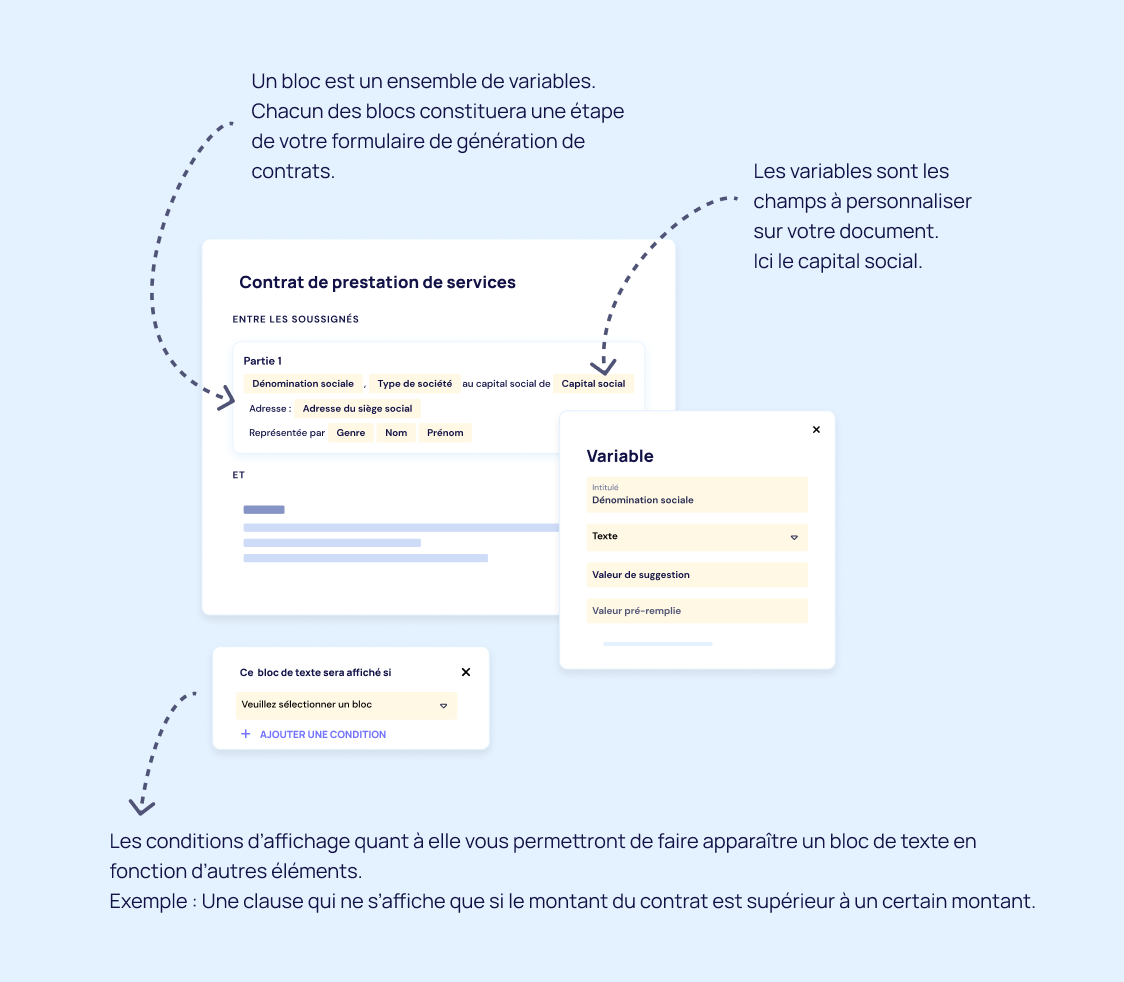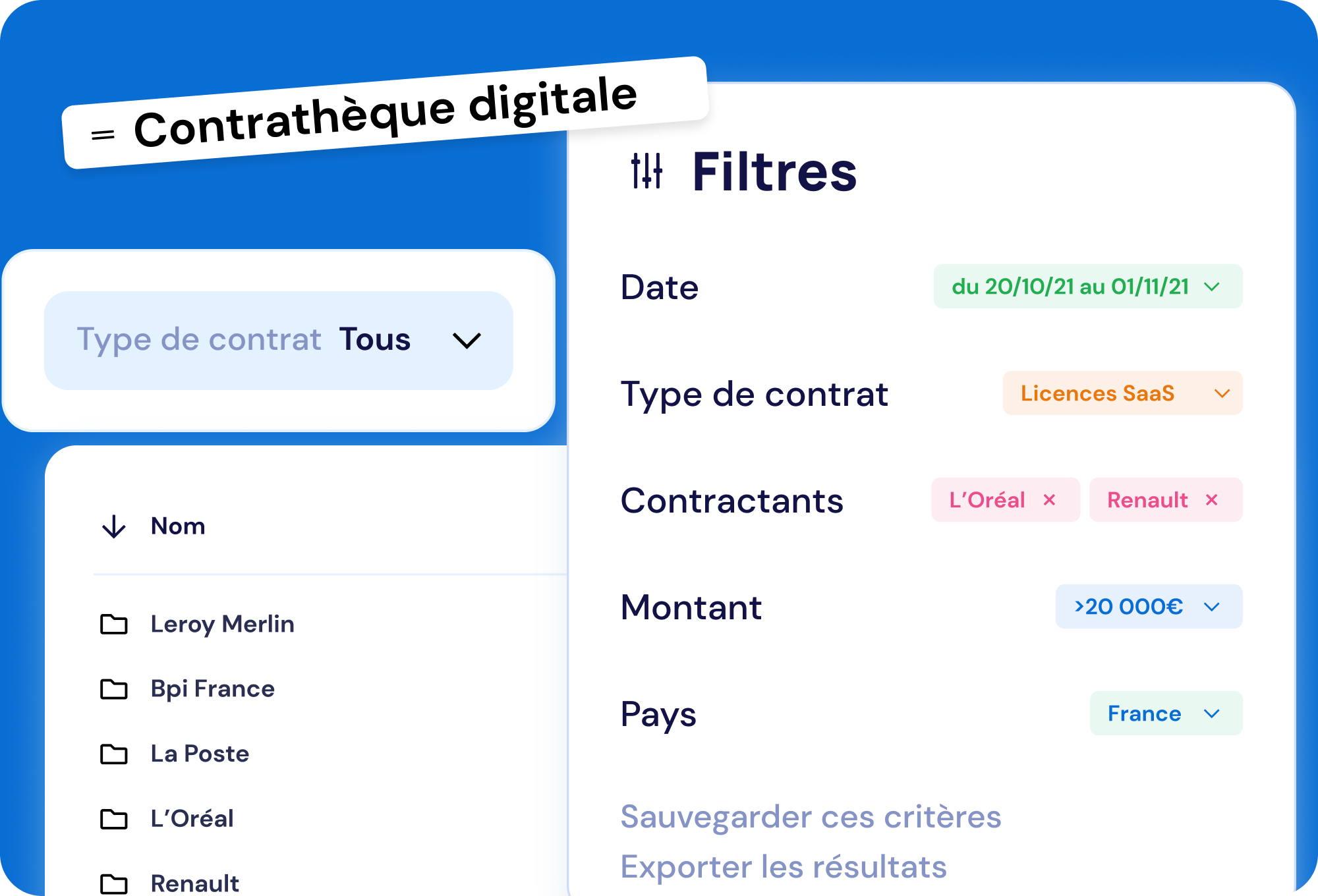The digital library has become an essential tool in business.
The contract library is not only legal. It is used by all stakeholders in the contractualization process.
- What is a digital library?
- What is the difference between an excel-control library and a software-control library?
- What are its advantages?
We explain why it is essential to use a digital contract library in your company.
What is a digital library?
A digital libraryThe digital contract library, also called contratech or software contrathèque, is a digitized library of contracts. First and foremost and not surprisingly, the contratech replaces the shelves and archive boxes containing paper copies but also the unsuitable archiving software.
A good contract library tool should allow you to perform the following actions:
- Self-service access to automated contract templates
- Archiving contracts that are being negotiated, signed, executed and/or completed
- Automatically retrieve and archive the signed version of your contracts on your electronic signature solution
- Save the contract activity feed and contract information
- Automatically generate a contract form (one pager) with the essential information of the contract
- Retrieve your stock of existing and new contracts Extract contract records
💡 Good to know: Like any storage tool, digital contract libraries can be charged by volume.
At Seraphin.legalwe have chosen not to adopt this billing method. Your objective is to conclude as many contracts as you need to grow your business. Our goal is to provide you with a seamless contracting experience to simplify your contracting process.
What is the difference between an Excel Contrast Library and a Contrast Library software?
excel contract library
Excel and Google Sheet are often the first tools used to track contracts in companies. This can be either a dynamic or static excel library.
When it is static, it contains a series of columns to be filled in manually. These columns represent the information tracked in the contract as well as a link to the contract source file.
In this case, the information is entered manually into the excel database once the contract is signed.
When it is dynamic, it is synchronised with all the tools used in the contract life cycle and updated automatically. In this case, entering the excel contract library triggers the creation of the contract.
◾ Word or Gdoc to generate the contract automatically from Excel.
◾ Docusign to indicate the status and date of signature of the contract.
◾ Drive or Sharepoint to automatically archive the contract and insert a link to the file.
Examples of information tracked:
◾ Status
◾ Signature
◾ Deadlines
◾ Clauses
◾ Amount
◾ Penalties
◾ Author
◾ Date of renewal
Contrast library software
There is no difference between a contract library software and a contract management software. Even if the most appropriate term is contract management software since the contract library is a feature.
Purpose: Excel is a spreadsheet that allows you to do many things with a little creativity. But excel was not thought and designed to create a digital contract library.
Complexity: A digital contract library has a simple graphical interface that allows a number of actions to be carried out without knowing the functions like Excel.
Data tracking: The digital contract library uses all the data in your contract to better analyse it. You no longer need to manually enter or merge Excel files to find the information you need.
Use a digital contract library to systematise the centralised archiving of contracts
Archiving is the primary function of a contract library. Once signed, a digital contract library worthy of the name should automatically archive the signed version.
However, an analysis of existing contract management practices within companies reveals numerous difficulties in this area.
- Management of contractual archives in silos (paper archiving, local archiving on employees' computers, etc.)
- Difficulty in searching for information according to criteria related to the contract (clause, amount, purpose, contracting party, date of signature etc.)
- Dispersion of contract data in different tools and servers
- Lack of visibility on contractual exchanges before and after the signing of the contract when it comes to documenting a dispute
Storage methods that are particularly risky when dealing with data as sensitive as that in our contracts.
As you know, a contract sets the rules of the game and is a reference in the relationship you have with your co-contractor. A contract is not a piece of paper to be put away in a drawer, but a mine of strategic information to be exploited after the contract is signed.
Emmanuelle Tannay, Contract Manager, talked about it a few months ago in the episode we dedicated to her on Paroles de Juristes 👇
Using a digital contract library to secure contract creation
As your business grows and more and more opportunities arise to be realised through a contract, the contract creation stage can be seen as a bottleneck.
As it is not the sole remit of the lawyer or legal team, depending on their workload, the time taken to create a contract can take longer than it should. This is why it is essential to make teams responsible for creating certain types of contracts.
Audrey Gillessen, Head of Legal at Ornikar, told us in an episode of Paroles de Juristes 👇
Conclude contracts without bringing legal into the loop so as not to miss any opportunities. Do not let salespeople create their own contracts for fear of legal risks. On both sides, the fears are legitimate and the subject can crystallise tensions in the company
This is where a digital contract library comes into its own to secure the creation of contracts.
A digital contract library will allow you to give your internal customers a hand in creating their contracts by completing a form. Beyond the obvious time saving, this system will allow you to parameterise the fields to be personalised and even the specific clauses to be displayed according to the answers given.
On Seraphin.legal, our no-code editor allows you to create blocks, variables, and set display conditions to make up the document creation form.
The blocks represent a block of questions
The variables represent the fields to be customized on your document.
The display conditions allow you to display a block of text according to the user's answers.
Thus, this allows you to transform a static document into a dynamic document.

Using a digital library to simplify information retrieval
Do you also receive messages from Jean-Michel in a hurry? Are you yourself in Jean-Michel's shoes and would you really like to be able to access all this data in less than 5 minutes? 😨
Your contracts are full of strategic information often requested by your teams and internal customers.
However, contract data has historically been scattered and in some companies it is not even usable.
- Contracts are stored in filing cabinets or boxes
- Contracts are scanned and stored in digital files
- Contracts are stored locally on employees' computers
Apart from the geographical dispersion of the files, a scanned or paper document makes it difficult to exploit its data.
That's why what should take you no more than 5 minutes takes you all morning.
We all agree that the exploitation of contractual information is made particularly difficult in this context.
A digital contract library should be your only source of truth when it comes to managing your contracts. It will allow you to make personalised queries using a powerful search engine and provide comprehensive answers without spending all day on it.

| Without a digital library | With a digital library | |
|---|---|---|
| Find contracts matching a list of criteria | An hour, a morning, even a day | In 2 minutes, by choosing your criteria in the search bar |
| Get a contract summary to understand it at a glance | Contract sheets and monitoring tables do not contain the same information from one employee to another, or from one team to another. | Contract records are automatically generated once the contract is created. |
| Unwinding the activity thread of a series of contracts negotiated with a certain co-contractor (audit trail) | Impossible in the face of the multitude of tools. You have to merge the information recorded via the word processing tool, the electronic messaging and the electronic signature solution. | It is possible to export the activity feed over the entire life cycle of the contract with one click. |
| Searching a scanned document | It is impossible to carry out precise searches on key words, types of clauses or amounts contained in the contract. The characteristics of each contract must first be listed in metadata in order to be able to exploit them. | Thanks to OCR, character recognition makes it possible to exploit the data contained in your scanned contracts. |



